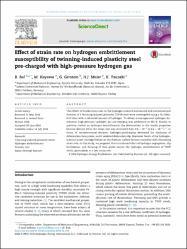Effect of strain rate on hydrogen embrittlement susceptibility of twinning-induced plasticity steel pre-charged with high-pressure hydrogen gas
Abstract
The effects of tensile strain rate on the hydrogen-induced mechanical and microstructural features of a twinning-induced plasticity (TWIP) steel were investigated using a Fe-23Mn-0.5C steel with a saturated amount of hydrogen. To obtain a homogeneous hydrogen distribution, high-pressure hydrogen gas pre-charging was performed at 423 K. Similar to previous studies on hydrogen embrittlement, the deterioration in the tensile properties became distinct when the strain rate was decreased from 0.6 x 10(-3) to 0.6 x 10(-4) s(-1). In terms of microstructural features, hydrogen-precharging decreased the thickness of deformation twin plates, and it localized dislocation slip. Moreover, facets of the hydrogen induced quasi-cleavage feature on the fracture surface became smoother with decreasing strain rate. In this study, we proposed that a combined effect of hydrogen segregation, slip localization, and thinning of twin plates causes the hydrogen embrittlement of TWIP steels, particularly at a low strain rate. (C) 2016 Hydrogen Energy Publications LLC. Published by Elsevier Ltd. All rights reserved.


















